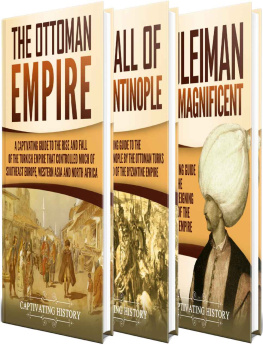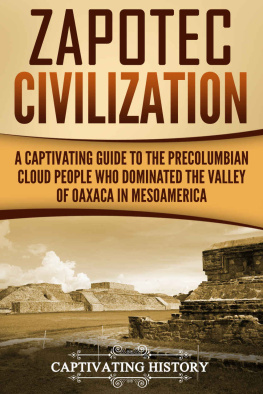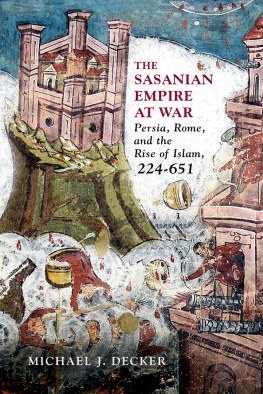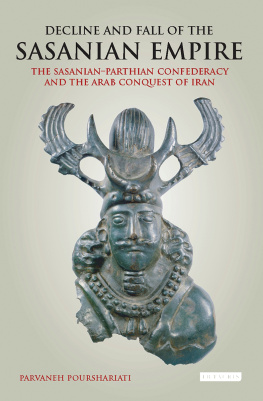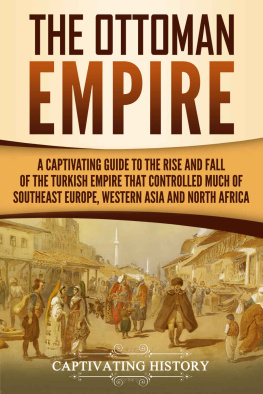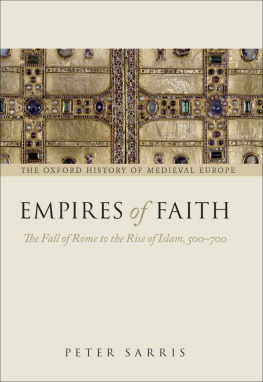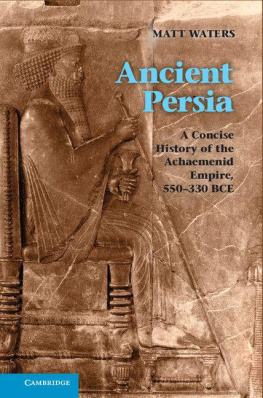History - Sasanian Empire: A Captivating Guide to the Neo-Persian Empire that Ruled Before the Arab Conquest of Persia and the Rise of Islam
Here you can read online History - Sasanian Empire: A Captivating Guide to the Neo-Persian Empire that Ruled Before the Arab Conquest of Persia and the Rise of Islam full text of the book (entire story) in english for free. Download pdf and epub, get meaning, cover and reviews about this ebook. year: 2018, genre: History. Description of the work, (preface) as well as reviews are available. Best literature library LitArk.com created for fans of good reading and offers a wide selection of genres:
Romance novel
Science fiction
Adventure
Detective
Science
History
Home and family
Prose
Art
Politics
Computer
Non-fiction
Religion
Business
Children
Humor
Choose a favorite category and find really read worthwhile books. Enjoy immersion in the world of imagination, feel the emotions of the characters or learn something new for yourself, make an fascinating discovery.
- Book:Sasanian Empire: A Captivating Guide to the Neo-Persian Empire that Ruled Before the Arab Conquest of Persia and the Rise of Islam
- Author:
- Genre:
- Year:2018
- Rating:4 / 5
- Favourites:Add to favourites
- Your mark:
- 80
- 1
- 2
- 3
- 4
- 5
Sasanian Empire: A Captivating Guide to the Neo-Persian Empire that Ruled Before the Arab Conquest of Persia and the Rise of Islam: summary, description and annotation
We offer to read an annotation, description, summary or preface (depends on what the author of the book "Sasanian Empire: A Captivating Guide to the Neo-Persian Empire that Ruled Before the Arab Conquest of Persia and the Rise of Islam" wrote himself). If you haven't found the necessary information about the book — write in the comments, we will try to find it.
History: author's other books
Who wrote Sasanian Empire: A Captivating Guide to the Neo-Persian Empire that Ruled Before the Arab Conquest of Persia and the Rise of Islam? Find out the surname, the name of the author of the book and a list of all author's works by series.
Sasanian Empire: A Captivating Guide to the Neo-Persian Empire that Ruled Before the Arab Conquest of Persia and the Rise of Islam — read online for free the complete book (whole text) full work
Below is the text of the book, divided by pages. System saving the place of the last page read, allows you to conveniently read the book "Sasanian Empire: A Captivating Guide to the Neo-Persian Empire that Ruled Before the Arab Conquest of Persia and the Rise of Islam" online for free, without having to search again every time where you left off. Put a bookmark, and you can go to the page where you finished reading at any time.
Font size:
Interval:
Bookmark:
A Captivating Guide to the Neo-Persian Empire that Ruled Before the Arab Conquest of Persia and the Rise of Islam
Copyright 2018
All Rights Reserved. No part of this book may be reproduced in any form without permission in writing from the author. Reviewers may quote brief passages in reviews.
Disclaimer: No part of this publication may be reproduced or transmitted in any form or by any means, mechanical or electronic, including photocopying or recording, or by any information storage and retrieval system, or transmitted by email without permission in writing from the publisher.
While all attempts have been made to verify the information provided in this publication, neither the author nor the publisher assumes any responsibility for errors, omissions or contrary interpretations of the subject matter herein.
This book is for entertainment purposes only. The views expressed are those of the author alone, and should not be taken as expert instruction or commands. The reader is responsible for his or her own actions.
Adherence to all applicable laws and regulations, including international, federal, state and local laws governing professional licensing, business practices, advertising and all other aspects of doing business in the US, Canada, UK or any other jurisdiction is the sole responsibility of the purchaser or reader.
Neither the author nor the publisher assumes any responsibility or liability whatsoever on the behalf of the purchaser or reader of these materials. Any perceived slight of any individual or organization is purely unintentional.
Table of Contents
Free Bonus from Captivating History: History Ebook
Hi History Lovers!
My name is Matt Clayton, and Im the creator of Captivating History. First off, I want to THANK YOU for reading our books in the Captivating History series. As an avid reader of History myself, I aim to produce books that will hold you captive.
Now you have a chance to join our exclusive history list so you can get the ebook below for free as well as discounts and a potential to get more history books for free! Simply click the link below to join.
P.S. If you join now, you will also receive a free Mythology book. Remember that its 100% free to join the list.

Click here to access your bonus
Also, make sure to follow us on:
Twitter: @Captivhistory
Facebook: Captivating History: @captivatinghistory
Introduction
Too often people tend to disregard Iranian history and its ancient empires as so-called bad guys, often barbaric and bloodthirsty, lacking the culture, morals, and finesse of westerners. This stems both from the fact that most of our modern ideas of antique history come from western historians whose countries fought against those empires and because of present-day prejudices caused by modern-day Iranian politics. Yet this is far from the truth. Starting from the first Persian Empire under the Achaemenids, culture, and achievements of the ancient Iranian states were astonishing, influencing nations far outside their borders. And that influence was probably the strongest during the Sasanian Empire which is today considered the pinnacle of ancient Iranian civilization and culture.
Under the rule of the Sasanid Dynasty, this empire revitalized Iranian culture, reviving Old Persian traditions, culture, and religion, and at the same time rejected the heritage of Greek influence left by the conquest of Alexander the Great. Because of that, their state is sometimes called the "Neo-Persian Empire." During their rule that spanned from 3 rd to 7 th century CE, the Sasanian Empire flourished, leaving many breathtaking works of art which inspired changes in many other cultures. Of course, that influence came from the fact that this empire was one of the mightiest of the time, at its greatest extent covering much of the present-day Middle East and parts of Central Asia. Positioned there, it played an important part in connecting the Chinese and Indian kingdoms to the east and European and Mediterranean states to the west, allowing it to be both a major military and economic power of the time, rivaling first the Roman Empire and then later the Byzantine Empire. Thanks to their success, historians today think their influence was crucial for forming medieval art both in Europe and Asia. And more importantly, their legacy became an integral part of what we today think of as Islamic culture.
For all those reasons, it is important to shake off misconceptions planted in our minds by prejudices coming from the past and the present and get more familiar with such an important part of the world cultural heritage. Hopefully, by the end of this brief guide, it will become clearer how important the Sasanian Empire was to history, leaving you yearning for more details about their story.
Chapter 1 Rise of the Sasanian Empire
To fully understand the background of the Sasanian state and how the Sasanid Dynasty became the rulers of the Neo-Persian Empire, we need to go way back to the foundation of the Achaemenid Empire. Their rule spread out from the region they called Parsa by the native population, while in Greek that province was called Persis. That province was located in present-day southern Iran, near the Zagros Mountains, spreading to the shores of the Persian Gulf. The Hellenized name of their homeland gave the name to the entire empire we today know as Persia. And from mid-6 th century BCE until late 4 th BCE, the first Persian Empire dominated the region, spreading their rule over three continents. For a short while, much of its territory was incorporated into the Macedonian Empire of Alexander the Great, who combined Greek, Persian, and other Eastern cultures into one amalgamated and unified culture. Thus, Hellenistic culture was created, which was in essence mostly Greek and wasnt that well accepted by the Persians. After Alexander passed away, his empire dissolved into several smaller Hellenistic states that fought over territories that were once under Persian control.
Most successful of them was the Seleucid Empire which ruled over most of what is today Iran, Iraq, the Levant (present-day Syria, Israel, Jordan, and Lebanon), and parts of Turkey. But by the 2 nd century BCE, they were pushed out of the Iranian Plateau by the Parthians from the Central Asian steppes. Parthians slowly denounced the Greek traditions and started turning toward earlier Persian culture, starting its revival; yet despite their best efforts, true Persians were never too fond of them. In their eyes, Parthians and their Arsacid Dynasty were always foreigners. Despite that, Persis remained more or less a loyal province of the Parthian Empire for as long as it was powerful enough to command them. Under the Parthian rule, Persis was a semi-autonomous kingdom which was allowed to mint its own coins. On them, archeologists have seen that tradition and memories of the glory days of the first Persian Empire were still around by the 3 rd century CE. But how vivid and how important it was to the population of Parsa we cannot be sure as there is no clear evidence about its history in pre-Sasanid times. What historians do know is that Parthian strength started to fade in the 2 nd century CE, as it was ever more engulfed in civil wars and struggles against the Roman Empire in the west. This weakened their control over the local rulers, allowing Ardashir I from the house of Sasan to rise up.
The story of the house of Sasan doesn't start with Ardashir, but the fog of history clouds our knowledge. There are three different narratives about his predecessors told by various sources. One is that his father Papak (or Babak) was a son of Sasan, founder of their dynasty. Second is that Sasan was married to the daughter of Papak after he found out that Sasan was of royal Achaemenid descent. The third narrative is that it was actually Papak who was married to the daughter of Sasan, with whom he had Ardashir. Modern historians theorize that the connection of Ardashir and Sasan was more distant and maybe even mythical, and was used to connect their dynasty with the Achaemenids, giving them a more viable claim to the throne. Another theory presented is that Sasan was indeed a biological father of Ardashir I but died soon after his sons birth. And in accordance with religious customs at the time, Papak adopted Ardashir. Whatever the exact truth was, sources hint that somewhere around 205 CE, Papak unsuccessfully rebelled against the Parthian rule. At the moment, he was already controlling most of the Parsa province. He was most likely helped by his elder son Shapur who was shown on his father's coins.
Font size:
Interval:
Bookmark:
Similar books «Sasanian Empire: A Captivating Guide to the Neo-Persian Empire that Ruled Before the Arab Conquest of Persia and the Rise of Islam»
Look at similar books to Sasanian Empire: A Captivating Guide to the Neo-Persian Empire that Ruled Before the Arab Conquest of Persia and the Rise of Islam. We have selected literature similar in name and meaning in the hope of providing readers with more options to find new, interesting, not yet read works.
Discussion, reviews of the book Sasanian Empire: A Captivating Guide to the Neo-Persian Empire that Ruled Before the Arab Conquest of Persia and the Rise of Islam and just readers' own opinions. Leave your comments, write what you think about the work, its meaning or the main characters. Specify what exactly you liked and what you didn't like, and why you think so.


